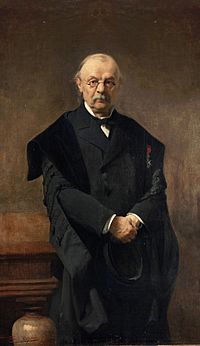Eugène Charles Catalan facts for kids
Quick facts for kids
Eugène Charles Catalan
|
|
|---|---|
 |
|
| Born | 30 May 1814 |
| Died | 14 February 1894 (aged 79) |
| Nationality | French, Belgian |
| Alma mater | École Polytechnique |
| Known for | Catalan numbers Catalan solid Catalan surface Catalan's conjecture Catalan's constant Catalan's identity Catalan's minimal surface |
| Scientific career | |
| Fields | Mathematics |
| Doctoral advisor | Joseph Liouville |
| Doctoral students | François Deruyts Charles Hermite Constantin Le Paige |
| Other notable students | Ernesto Cesàro |
Eugène Charles Catalan (born May 30, 1814 – died February 14, 1894) was a smart mathematician from France and Belgium. He studied many areas of math, like how numbers behave, how shapes are described, and how to count different possibilities. He is famous for discovering a special curved surface, for a math puzzle called Catalan's conjecture (which was solved in 2002), and for introducing "Catalan numbers" to help solve counting problems.
About Eugène Charles Catalan
Eugène Charles Catalan was born in Bruges, a city now in Belgium, in 1814. He was the only child of a French jeweler. In 1825, he moved to Paris, France, to study mathematics at a famous school called École Polytechnique. There, he met another important mathematician, Joseph Liouville, in 1833.
In December 1834, Catalan and many other students were temporarily sent away from the school for political reasons. He started his studies again in January 1835 and finished that summer. After graduating, he began teaching in Châlons-sur-Marne.
Catalan later returned to the École Polytechnique. With help from Liouville, he earned his math degree in 1841. He then taught descriptive geometry at Charlemagne College. Catalan was very interested in politics and supported left-wing ideas. He even took part in the 1848 Revolution in France. Despite his political activities, he had a successful career and was even a member of France's Chamber of Deputies (a type of parliament). In 1849, the French police visited his home looking for illegal teaching materials, but they didn't find anything.
In 1865, the University of Liège in Belgium made him a professor of analysis, a branch of mathematics. In 1879, he became an editor for a math journal. He even published a theory from another mathematician, Paul-Jean Busschop, as a footnote, even though he had initially thought it was "too empirical" in 1873. In 1883, he worked for the Belgian Academy of Science, focusing on number theory. He passed away in Liège, Belgium, where he had been a respected professor.
What Eugène Catalan Studied
Eugène Catalan worked on several important areas of mathematics:
- Continued fractions: These are special ways to write numbers as fractions within fractions.
- Descriptive geometry: This is about drawing 3D objects on a 2D surface, like a piece of paper.
- Number theory: This field explores the properties and relationships of numbers.
- Combinatorics: This is the study of counting, arranging, and combining objects.
In 1855, he discovered a unique curved shape called a "periodic minimal surface." It's a special kind of surface that has the smallest possible area for its boundaries. Before that, in 1844, he proposed a famous math puzzle known as Catalan's conjecture. This puzzle was finally solved in 2002 by a Romanian mathematician named Preda Mihăilescu. Catalan also introduced the idea of Catalan numbers. These are special numbers that help solve many different counting problems in combinatorics.
See also
 In Spanish: Eugène Charles Catalan para niños
In Spanish: Eugène Charles Catalan para niños
- Catalan pseudoprime
- Catalan's triangle
- Catalan–Dickson conjecture
- Catalan–Mersenne number conjecture
- Catalan beta function
- Fermat–Catalan conjecture
- Fuss–Catalan number

